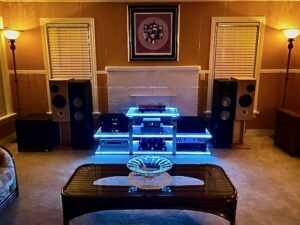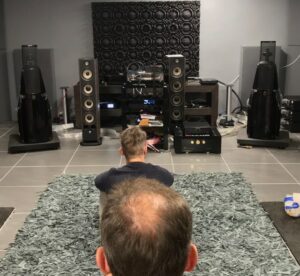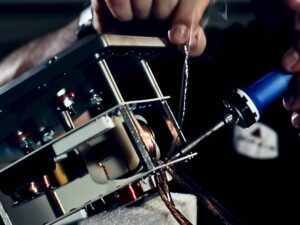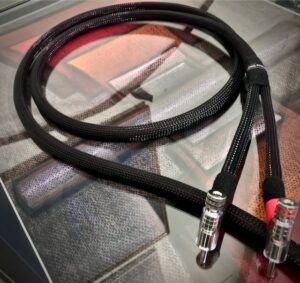
The Wire and audiophile wire
The Speaker wire makes the electrical connection between loudspeakers and audio amplifiers. Modern speaker wire consists of two or more electrical conductors. And individually insulated by PVC, PE, Teflon, or rubber. The two wires are electrically identical but marked to identify correct polarity. Most widely, speaker wire comes in the form of a zip cord.
The effect of speaker wire on the signal has been a much-debated topic in the audiophile and high-fidelity worlds. However, the accuracy of any advertising claims on these points is varied. And engineers emphasise that simple electrical resistance is the most critical characteristic of speaker wire. Wire and audiophile wire
Resistance
Resistance is an essential specification of speaker wire. Low-resistance speaker wire allows amplifier power to energize the loudspeaker’s voice coil. And performance of conductors (such as a speaker wire) is optimised by limiting the length and maximising the cross-sectional area. Depending on the listener’s hearing ability, this resistance begins to have an audible effect when the resistance exceeds 5 per cent of the speaker’s impedance.
A speaker wire’s impedance takes into account the wire’s resistance, the wire’s path, and the dielectric properties of local insulators. And the latter two factors also determine the wire’s frequency response. The lower the speaker’s impedance, the greater significance the speaker wire’s resistance will have. Wire and audiophile wire
The Audiophile
An audiophile is a person who is enthusiastic about high-fidelity sound reproduction and seeks to reproduce the sound of a piece of recorded music. Typically inside closed headphones or a room with good acoustics. The Audiophile values applied at all stages of music reproduction: the initial audio recording, the production process, and the playback. And In general, the values of an audiophile are seen to be antithetical to the growing popularity of more convenient but lower-quality music—for example, lossy digital files, lower-definition streaming services, and inexpensive headphones.
The term high-end audio refers to playback equipment used by audiophiles at specialist shops and websites. High-end components include turntables, DAC, equalisation devices, preamplifiers and amplifiers. Also loudspeakers (including horn, electrostatic and magneto-static speakers). Also, power conditioners, subwoofers, headphones, and acoustic room treatment.
ABX testing
ABX testing is a method of comparing two choices of sensory stimuli to identify detectable differences between them. For example, the person supplied two known samples (sample A, the first reference, and sample B, the second reference) followed by one unknown sample X, randomly selected from either A or B. The subject is then required to identify X as either A or B. Suppose X cannot be determined reliably with a low p-value in a predetermined number of trials. In that case, the null hypothesis cannot be rejected. And cannot be proven there is a perceptible difference between A and B
Low resistance
Resistance is by far an essential specification of speaker wire. Low-resistance speaker wire allows amplifier power to energise the loudspeaker’s voice coil. And performance of conductors (such as a speaker wire) is optimised by limiting the length and maximising the cross-sectional area. Depending on the listener’s hearing ability, this resistance begins to have an audible effect when the resistance exceeds 5 per cent of the speaker’s impedance.
A speaker wire’s impedance takes into account the wire’s resistance, the wire’s path, and the dielectric properties of local insulators. The latter two factors also determine the wire’s frequency response. The lower the speaker’s impedance, the greater significance the speaker wire’s resistance will have.
Wire gauge
As speaker impedance drops, lower gauge (heavier) wire is needed to prevent degradation to damping factor – a measure of the amplifier’s control over the voice coil’s position. Also insulation thickness also has no audible effect as long as the insulation is of good quality and does not chemically react with wire.
High-power in-car audio systems using 2-ohm speaker circuits require thicker wires than 4 to 8-ohm home audio applications. And most consumer applications use two conductor wires. A common rule of thumb is that the resistance of the speaker wire should be at most 5 per cent of the rated impedance of the system.
The gauge numbers in SWG and AWG reduce as the wire gets larger. Sizing in square millimetres is shared outside of the US. Suppliers and manufacturers often specify their cable in strand count. A 189-strand count wire has a cross-sectional area of 1.5 mm2 which equates to 126.7 strands per mm2.
Wire material
The use of copper or copper-clad aluminium (CCA) is more or less universal for speaker wire. And copper has low resistance compared to most other suitable materials. CCA is cheaper and lighter, at the expense of somewhat higher resistance (about the same as copper two AWG numbers up). Copper and aluminium both oxidise, but the oxides of copper are conductive, while aluminium’s oxides are insulating.
Also offered is Oxygen-free Copper (OFC), sold in several grades. The various stages marked as having better conductivity and durability. But they have no significant benefit in audio applications. Commonly available C11000 Electrolytic-Tough-Pitch (ETP) copper wire is identical to higher-cost C10200 Oxygen-Free (OF) copper wire in speaker cable applications. Much more expensive C10100, a highly refined copper with silver impurities removed and oxygen reduced to 0.0005 per cent, has only a one per cent increase in conductivity rating, insignificant in audio applications.
Silver has a slightly lower resistivity than copper, which allows a thinner wire to have the same resistance. However, Silver is expensive, so copper wire with the same resistance costs considerably less. Also, Silver tarnishes, forming a thin surface layer of silver sulphide. Gold has a higher resistivity than copper or Silver, but pure gold does not oxidise and used for plating wire-end terminations.
Conclusion
Wire and audiophile wire are different in the way there are constructed. And it is essential to check the specifications and the credibility of the manufacture of the wire and the cable the wires are in. Today a person has unlimited access to information and it is not hard to check anything needed in the audiophile world.
If you have enjoyed reading ‘Wire and audiophile wire’, (information taken from wikipedia) please share with friends and colleuges – thank you
Perkune Best budget audiophile cables



